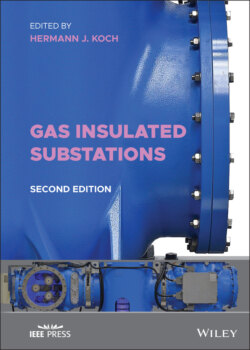Читать книгу Gas Insulated Substations - Группа авторов - Страница 73
1.4.3 Rated Insulation Level
ОглавлениеThe ratings for insulation levels are derived from the network to which the GIS is connected. Network conditions, like lightning strokes into overhead lines, their local probability, and their expected strength, are indicators for the overvoltage that may occur. In the case of cable networks, the length of cables and their related overvoltage during switching operations will influence this rating.
Rated insulation levels are key parameters for the design of GIS and do have a direct impact on the enclosure diameter and, with this, a high‐cost impact in development and manufacturing cost. Each rated voltage in IEC and IEEE has the choice of two or even more insulation levels. In GIS, the choice is usually made in favor of the highest requirement for the GIS.
As shown in Table 1.5, in most cases the listed rated power frequency withstand voltage, the rated switching impulse withstand voltage, and the rated lightning impulse withstand voltage for the related rated maximum voltage is the highest value from IEC and IEEE standards. Only the rated maximum voltage classifications of 245 and 362 kV have the choice of two voltage levels. The reason behind these choices is that, in North America, many such GIS are in operation from the past, while the rated insulation levels of today’s GIS offer higher values.
Table 1.5 Rated voltages of IEEE and IEC
| Rated max voltage U m | Rated power frequency withstand voltage | Rated switching impulse withstand voltage | Rated lightning impulse withstand voltage (BIL) | ||
|---|---|---|---|---|---|
| IEC | IEEE | kV rms | kV rms | kV peak | kV peak |
| × | × | 72.5 | 140 | — | 325 |
| × | × | 100 | 185 | — | 450 |
| × | × | 123 | 230 | — | 550 |
| × | × | 145 | 275 | — | 650 |
| × | × | 170 | 325 | — | 730 |
| × | 245 | 425 | — | 900 | |
| × | × | 245 | 460 | — | 1050 |
| × | × | 300 | 460 | 850 | 1050 |
| × | 362 | 500 | 850 | 1050 | |
| × | × | 362 | 520 | 950 | 1175 |
| × | × | 420 | 650 | 1050 | 1425 |
| × | × | 550 | 710 | 1175 | 1550 |
| × | × | 550 | 740 | 1175 | 1550 |
| × | × | 800 | 960 | 1425 | 2100 |
| × | × | 1100 | 1100 | 1800 | 2400 |
